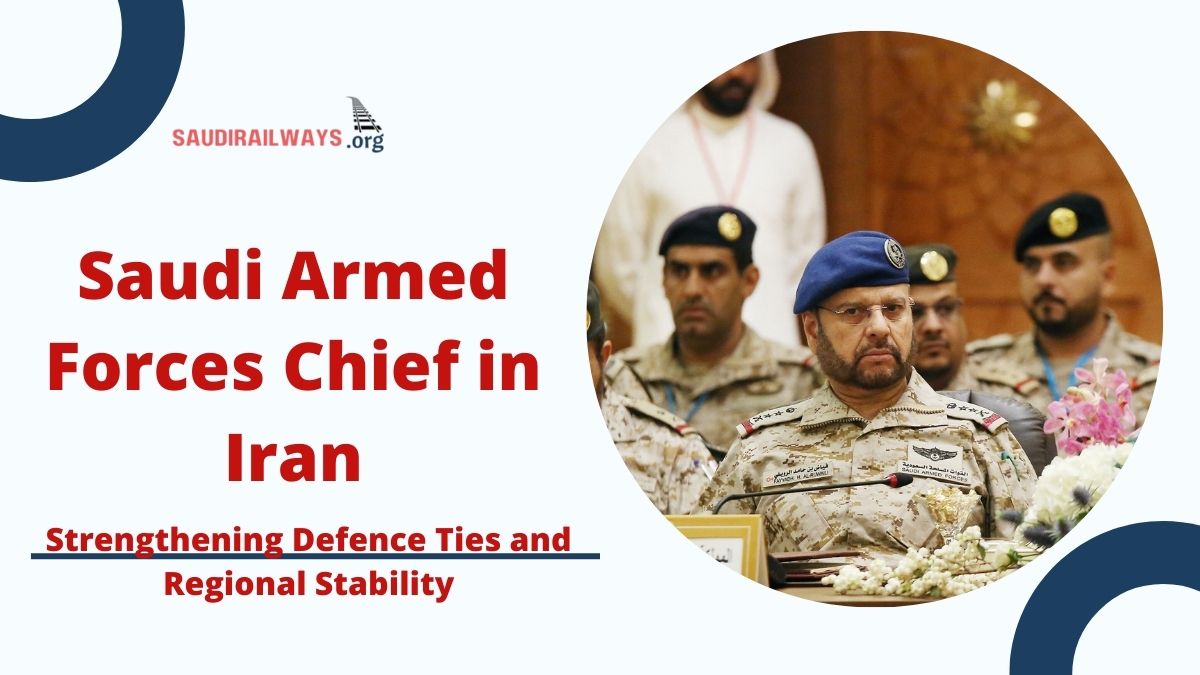The Gulf region witnessed a pivotal diplomatic development as Saudi Arabia’s Chief of Staff, Fayyad al-Ruwaili, arrived in Tehran for high-level talks with Iranian officials. This visit marks a rare, high-profile meeting between two nations that have historically been at odds, signaling a new era of cooperation and potential stability in the Middle East.
The discussions are set to focus on strengthening defence relations, building on the renewed ties established through a China-brokered agreement in March 2023.

Contents
A Historic Turn in Saudi-Iran Relations
Relations between Saudi Arabia and Iran have been tumultuous for decades, defined by geopolitical rivalry and divergent ideologies. However, a turning point came in March 2023, when the two countries restored diplomatic ties under a surprise deal facilitated by China.
This agreement marked the end of a seven-year freeze, during which both nations backed opposing factions in conflicts across the region, from Syria to Yemen.
Key Events Leading to the Renewed Ties:
Event |
Date |
Details |
|---|---|---|
Severing of Diplomatic Ties |
January 2016 |
Saudi embassies in Iran were attacked during protests. |
China-Brokered Reconciliation Deal |
March 2023 |
Restored diplomatic relations after a seven-year rift. |
Initial Defence Talks |
November 2023 |
Phone call between military officials initiated cooperation. |
Saudi Army Chief’s Visit to Iran |
November 2024 |
High-level meeting to discuss defence cooperation. |
This visit is seen as a continuation of the efforts to bridge gaps and foster mutual understanding, with a focus on defence diplomacy.
Agenda of the High-Level Talks
The discussions between Saudi Arabia’s Chief of Staff, Fayyad al-Ruwaili, and his Iranian counterpart, General Mohammad Bagheri, are expected to cover several critical areas, including:
- Defence Diplomacy
- The primary focus of the meeting is to strengthen defence ties and build a framework for future military cooperation. This includes joint exercises, intelligence sharing, and coordinated efforts in maritime security.
- Regional Security and Stability
- Both nations are keen to address the ongoing security challenges in the region. Discussions may include joint efforts to combat terrorism, secure maritime routes, and reduce the risk of conflict in the Gulf of Oman and the Red Sea.
- Naval Cooperation
- Iranian media has reported that the possibility of the Saudi Navy joining Iranian naval exercises is on the table. This initiative could be a significant step towards enhancing trust and transparency between the two military forces.
- Broader Bilateral Cooperation
- Beyond defence, the talks may also touch on economic partnerships and cultural exchanges, as part of a broader strategy to normalize relations and rebuild trust.
Implications for the Middle East
The visit of Saudi Arabia’s top military official to Iran is a strategic move with far-reaching implications for the broader Middle East:
- Increased Regional Stability
- Enhanced defence cooperation between Saudi Arabia and Iran could lead to greater stability in the region, reducing the risk of military confrontations and fostering a more secure environment for economic growth.
- Impact on Yemen and Syria Conflicts
- Both nations have been key players in the conflicts in Yemen and Syria, backing opposing factions. Improved diplomatic relations may pave the way for peace talks and a potential resolution to these long-standing conflicts.
- China’s Growing Influence
- The China-brokered deal highlights Beijing’s growing role in Middle Eastern diplomacy, challenging the traditional dominance of Western powers in the region. This shift could reshape the dynamics of international relations in the Gulf.
Expert Opinions
Experts believe that this visit marks a turning point in Saudi-Iran relations, with the potential to usher in a new era of cooperation and mutual understanding.
Political analysts note that while the path to full normalization will be complex, the current trajectory indicates a willingness from both sides to engage in dialogue and build a more stable future.
Professor Ahmed Al-Bashir, a Middle East affairs specialist, states:
“This visit symbolizes a thawing of relations that could have a ripple effect across the region. Both countries have realized the benefits of reducing tensions and working together, especially in areas of shared interest like counter-terrorism and maritime security.”
Future Outlook: What’s Next for Saudi-Iran Defence Relations?
The meeting between Saudi Arabia’s army chief and Iranian officials could be the first of many steps towards establishing a more collaborative relationship. Here’s what we can expect in the coming months:
Potential Development |
Impact |
|---|---|
Joint Naval Exercises |
Enhanced maritime security and reduced risks of conflict. |
Increased Intelligence Sharing |
Improved counter-terrorism efforts across the region. |
Formal Defence Agreements |
Potential signing of bilateral defence pacts for sustained cooperation. |
Regular High-Level Meetings |
Continued dialogue to maintain momentum in diplomatic relations. |
These developments would not only strengthen ties between Saudi Arabia and Iran but also contribute to a more secure and stable Middle East.
Conclusion
The visit of Saudi Arabia’s army chief to Iran marks a significant milestone in the evolving relationship between the two nations. By prioritizing defence diplomacy and seeking common ground, both countries are taking proactive steps towards fostering peace and stability in the region.
While challenges remain, the ongoing dialogue and willingness to engage are promising signs of a new chapter in Saudi-Iran relations.
As the world watches closely, this historic visit could set the stage for greater cooperation and a more unified approach to addressing regional issues.

I am a passionate technology and business enthusiast, constantly exploring the intersection where innovation meets entrepreneurship. With a keen eye for emerging trends and a deep understanding of market dynamics, I provide insightful analysis and commentary on the latest advancements shaping the tech industry.
